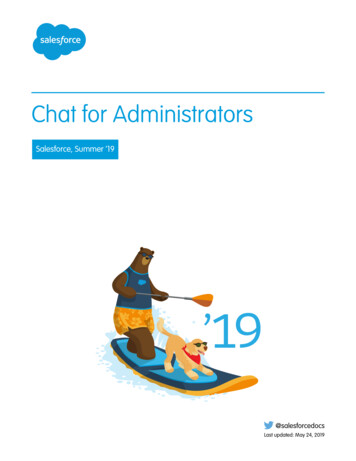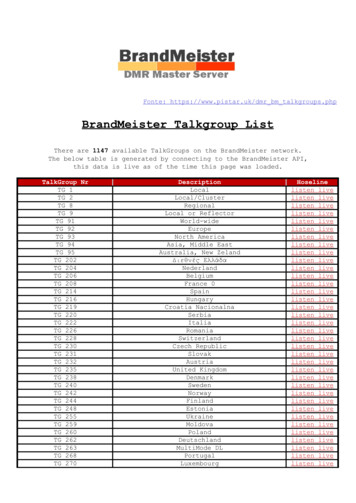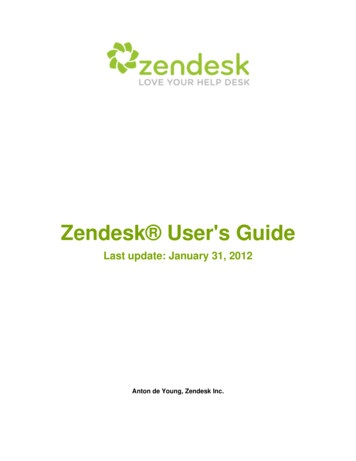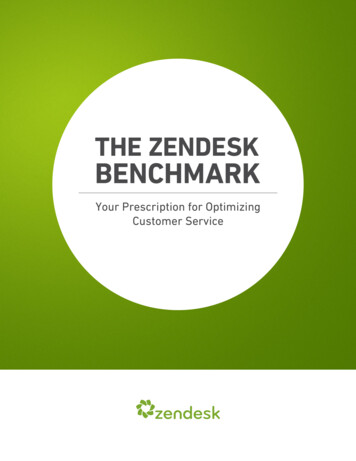
Transcription
Zendesk ResearchZendesk ResearchLive Chat1
Zendesk Research2In focus: ChatThe popularity of live chat for customer service is rising fast. Increasingly, consumers turn to live chat when shopping online, and a growing number of consumers say that live chat is their preferred way to engage with support. The launch of Facebook’s Businesses on Messenger, which letsbusinesses reach customers wherever they might be, is just one example of the growing ubiquity of live chat. So how can companies use livechat to transform the way they engage with customers? This report explores key performance indicators to benchmark chat support. For example,did you know that companies across all industries and geographies engage in 62 chat conversations a month and respond within 1 minute 36seconds? Benchmark metrics for live chat: We’ve created metrics that allow companies to measure their performance on live chat. For instance,a typical company serves 62 chat conversations each month and responds within 1 minute 36 seconds. How live chat changes customer engagement: When given the choice, customers choose to chat. We discovered that companieswho offer live chat support see a decline in tickets submitted through other web-based channels. What makes a great live chat experience: We confirmed that good live chat satisfaction ratings are associated with faster reply timesand fewer chats per agent. And we found another factor that plays a role: the number of messages exchanged during the chatconversation. What to consider when staffing for live chat: Understanding when chat request volume peaks can help companies decide how toallocate agent resources. In our customer sample, over 50% of chats occur between the peak hours of 10:00 a.m. and 3:00 p.m.What to consider when staffing for live chat: Understanding when chat request volume peaks can help companies decide how toallocate agent resources. In our customer sample, over 50% of chats occur between the peak hours of 10 a.m. and 3 p.m. In otherbenchmark news, our movers and shakers.The rise of real-time customer supportAs more and more customer interactions take place online, consumers expect help to be available when and where they need it. That’s why livechat, which offers a quick and convenient way to get support, is increasingly becoming the preferred way to contact customer service. Over thelast five years, the number of U.S. online shoppers who used live chat increased from 38% to 58%. Companies experience benefits, too: With livechat, agents can manage multiple conversations at once. They can even proactively start conversations with website visitors who may need helpnavigating the online purchasing process. Finally, chat is a clear winner for customer satisfaction: Compared to other support channels, live chatcomes out on top (Figure 1).
Zendesk Research3FIGURE 1: The customer satisfaction rate for live chat beats all ticket channels.92%88%85%85%84%Given its rapidly rising popularity, many companies want a better understanding of howoffering live chat to their customers will impact the way they run their businesses. To helpclarify how live chat changes the way companies engage their customers, we’ve examineddata from businesses that provide real-time support using Zendesk Chat. This reportuncovers: How live chat support performance compares across industries How offering live chat changes how companies provide customer service What factors improve the odds of a good satisfaction rating for a chatconversationWe also spoke with a number of companies using Zendesk to gather their real worldlive chat best practices.Live chat can transform customer service for the better. We found that 30 days afterimplementing live chat, ticket volume from embedded web forms plummets—suggestingthat customers prefer to communicate with support directly from the company website,instead of waiting for a response to arrive via email. We also found some interestingrelationships in the live chat data. There is a positive correlation between a company’slive chat customer satisfaction rating and the average number of messages exchangedbetween an agent and visitor during a chat conversation. There’s also a tendency forlive chat customer satisfaction to fall as the number of chats per agent rises. Together,these findings suggest that companies need to look for the optimal balance betweenagent workload and customer experience.Every company is different, and what works for one may not work for all. Therefore, eachsupport team should experiment to find the performance targets, staffing model, and bestpractices that work for them. Though it requires work, we think the benefits of engagingwith customers over live chat speak for themselves. We hope this report will serve as ahelpful resource for all companies exploring live chat, whether they are optimizing anexisting channel or implementing for the first time.T WI T T E RFAC E B O O KEMAILW E B FO R MVO I C EC HAT77%CUSTOMER SUCCESS STORY: EDMUNDSEdmunds.com helps car shoppers buysmarter by helping them discover, price,and buy the car that is right for them, fromanywhere at anytime. The Edmunds LiveHelp team, managed by Justin Smith, feelsit is important that their customers can gethelp any way they like—whether by phone,text, email, or, increasingly, live chat.Almost half of Edmunds’ support tickets arethrough live chat, which not only providesan effortless experience for customersalready seeking information on theEdmunds website, but allows the Edmundsteam to answer questions more efficiently.“Each agent is able to take multiple chats atonce,” Justin Smith explains. “Whereas, onthe phone, each agent can only take onecall at a time.”With Zendesk Chat, Edmunds’ seven agentshave over 1,200 real-time conversationsper month, and their customers love it: Thesatisfaction rating for their live chat channelstands at 93%.
Zendesk Research4Benchmark metrics for live chatFor this report, we’ve created new metrics specific to live chat. These measures can provide a sense of what to expect when implementinglive chat for the first time and function as helpful reference points for improving live chat performance.CUSTOM E R SAT I SFAC T I ON92%% of chat conversations that receive positivecustomer feedbackWith Zendesk Chat, a customer can provide a“thumbs up or down” voluntarily at any point during achat or in response to an agent request for a rating.CHATS/MON T HF I R ST R E P LY T I M E6201MIN 36SECNumber of live chat conversations per monthNumber of live chat conversations per month% MISSED C H ATSD U R AT I O N16%10MIN 35SEC% of customer-initiated chats without anagent responseLength of chat conversationCHATS/AG E N TM E S SAG E S / CH AT22Number of live chats each agent must serveper month10Number of messages exchanged during a chatconversationIT & consultancy companies lead, travel companies lag, in live chat satisfactionAlthough many different types of companies rely on live chat, performance benchmarks vary from one industry to the next. While IT & consultancycompanies achieve the highest live chat satisfaction ratings (96% of rated chat conversations received positive feedback), those in the travelindustry see the lowest (87%). But that doesn’t mean that live chat just isn’t good for travel companies: In the next section, we’ll see how theseinter-industry differences are more than skin deep.Satisfaction at scale remains a challenge with chatIn a previous Zendesk Research report (“In Focus: Operational Benchmarking”), we discussed the challenge of growing support operations.We found a negative correlation between a company’s customer satisfaction and their monthly ticket volume. In other words, as the number ofsupport requests increases, overall customer satisfaction tends to decline. We were curious to see if there was a similar relationship between acompany’s chats per month and their live-chat satisfaction rating. Sure enough, we found similar results: As the number of chat conversations permonth increases, customer satisfaction goes down (Figure 2).
Zendesk Research5FIGURE 2: Live chat customer satisfaction decreases as the number of chats per month increasesL IVE CHAT SAT IS FACT ION RAT ING ( % )98%96%94%92%90%88%86%84%05001,0001,5002,0002,500# O F C H ATS P E R M O N T HWith this information in mind, the differences between industries make more sense. It’s not that travel companies are bad at live chat. They simplyhave a larger workload of chat conversations than the businesses in IT & consultancy. Their median chats per month is 92, significantly higher thanthe global benchmark’s 62 and soaring above IT & consultancy’s 45. No matter whether you look at real-time or traditional support, the larger theworkload gets, the more challenging it becomes to provide a great customer experience.Mexico manages the highest volumes, Denmark provides the swiftest repliesWe found variation in live chat performance between countries, too (Figure 3). Companies in Mexico appear to be the chattiest, with a median143 chats per month. Companies in Denmark, home to Zendesk’s founders, keep things fast and simple—they deliver the swiftest reply times, at 1minute 9 seconds, and are the most concise, averaging 7.7 messages per chat conversation.FIGURE 3: Industry and geographic trends in live chat performance.IND UST RYH IG H EST CH AT VOLUM ELOWEST CH AT VOLUMEM OST MES SAGES /CH ATF E W EST MES SAG ES /C HATFASTEST TO REP LYS LOWEST TO REP LYL E AST MIS S EDM OST MIS S EDC O UN T RYE NT E RTAIN M E N TM E XI C O135 C HATS / M O N T H143 C H ATS / M O N T HRE AL E STAT EI TALY39 C H ATS / M O N T H27 C H ATS / M O N T HSOFT WAREI TALY12.012.8M E S SAG E S / C H ATM E S SAG E S / CH ATHE ALT HCA R ED E N M AR K8.3 ME S SAG E S / CH AT7.7 M E S SAG E S / CH ATE NT E RTAIN M E N TD E N M AR K01MIN 10S E C01M I N 09S E CNON-PROF I TSGE R M AN Y02MIN 02S E C02M I N 07S E CWE B APPSM E XI C O10%12%HE ALT HCA R EN E T HE R L AN D S21%19%
Zendesk Research6How live chat affects volume in other channelsWhile live chat makes it easier for customers to reach support, it doesn’t mean inviting more requests than your agents can handle. Actually,live chat can divert requests from ticket queues, instead sending them directly to agents for rapid resolution. Mia Chapa is the Customer CareManager at Sole Society, an ecommerce site that sells high quality shoes and accessories at affordable prices. She was pleasantly surprisedwhen she introduced live chat. “Chat is easy and low effort for our customers. Not only have our customers responded positively to chat, but itdecreased volume in our other support channels.”To understand how live chat changes the way customers engage support, we looked at how much each channel contributed to the supportworkload before and after implementing live chat (Figure 4). We found large contractions in the ticket volume generated by web forms, feedbacktabs, and APIs (which are commonly used to create custom web forms) (Figure 5). In other words, live chat absorbed a large volume of requeststhat visitors would normally submit through other, less immediate, channels.FIGURE 4: After implementing Zendesk Chat, the volume of requests to embedded web forms declinespct beforepct after403530252015105ZOPIMWEB FORMVOICETWITTEROTHERFEEDBACK TABFACEBOOKE MAILAPI0Companies using embedded web forms today will probably see many requests redirected to live chat as website visitors who would normallysubmit a form with their questions instead see a prompt to chat in real time. That lets agents respond quickly when it matters most: while acustomer is comparing products, reading content, or completing the check-out process.
Zendesk Research7FIGURE 5: An embedded web form for ticket submission. When live chat appears on the website, customers often opt for a real-timeconversation over a web form, allowing agents to answer website visitors’ questions quickly, even in the middle of a purchase.Contact usProduct sEmploymentSUBMITThe volume of tickets submitted over email contracts, too, but the effect is not as dramatic. Customers who submit tickets through email are lesslikely to be looking at the company website when they ask for help; therefore, chat is not an immediately available alternative when they submitservice requests. The takeaway: Chat deflects support volume from less efficient channels, but the effect of chat on a company’s ticket volumewill depend upon how its customers contact support today.Balancing agent workload with customer satisfactionWhat makes live chat customer service great? We looked at a number of variables to find out which ones were related to live chat customersatisfaction. We weren’t surprised that customers prefer short wait times: We expected, and found, a negative correlation between live chatcustomer satisfaction and first reply time. However, we found two factors that are even stronger drivers of live chat customer satisfaction: (1) thesize of the agent’s chat workload (measured in chats per agent per month), and (2) the amount of back-and-forth conversation between the agentand end-user (measured in messages per chat). So while companies should worry about wait times, they also need to make sure their agentsaren’t stretched too thin to provide each customer individual attention.Finding the right number of chats per agentZendesk customer Tucows operates Hover, a domain name registration service, as well as OpenSRS, a platform for domain resellers, and Ting, awireless service provider. When Ross Rader, Vice President of Customer Experience, first implemented Zendesk Chat, it was hard to know howmany concurrent chats his agents could manage. “At first we encouraged our agents to manage many chats at once,” Rader explained. “But westarted to see a dip in customer satisfaction.”Rader’s experience aligned with our research. We found a negative correlation between the number of chats per agent per month and live chatcustomer satisfaction (Figure 6). Although live chat allows agents to respond to more than one customer at once, as agents start handling moreand more chats, the increased workload may impact their ability to respond quickly and thoroughly.
Zendesk Research8FIGURE 6: Customer satisfaction declines as chats per agent increasesLIVE CHAT SAT IS FACT ION RAT ING ( % )98%96%94%92%90%88%86%84%050100150200250300350# OF C HATS P E R AG E N T P E R M O N T HAfter taking a closer look at their live chat analytics and talking to companies more experienced with live chat, Rader and his team discoveredthat aiming for a 30-second reply time was the magic number to provide their customers with the best experiences. “If you can’t get back to acustomer in 30 seconds, you’re probably handling too many chats. That takes a new agent from four chats down to one, and experienced agentsfrom six or seven down to two or three, and a super agent from ten or twelve down to four. Rightsizing the number of interactions an agent canhandle was an interesting process for us.”Like Chapa at Sole Society, Rader is also experiencing a shift in how his customers contact support. He says that live chat will soon eclipse phonesupport as their primary channel. This trend not only means greater agent efficiency (since Rader estimates the agent-to-customer ratio is at leastthree to four times higher on live chat than phone), it also means better customer experiences, since Tucows can be available whenever andwherever their customers expect.Customers are willing to wait for attentive serviceIt’s no surprise that wait time plays a role in how customers rate the quality of a support experience, and it wasn’t difficult to spot this trend in ourdata. There’s a clear negative relationship between live chat customer satisfaction and the amount of time a customer spends waiting to hearback from an agent (Figure 7). But the full story is a little more complicated, and we found a good reason to believe that companies can recoverfrom potential bad ratings stemming from long wait times by providing attentive customer service.
Zendesk Research9L IVE CHAT SAT IS FACT ION RAT ING ( % )FIGURE 7: Long wait times can bring down customer satisfaction96%94%92%90%88%86%84%050100150200250FI R ST R E P LY T I M E (S E CO N D S )L IVE CH AT SATI S FAC T I O N R AT I N G (%)We found one variable that, unexpectedly, had an even stronger association with live chat customer satisfaction than time to reply: the averagenumber of messages per chat. There’s a tendency for customer satisfaction to increase as more messages are exchanged between an agent andcustomer during the chat conversation (Figure 8). We aren’t sure exactly what drives this relationship. (It could be that some customers are botheasily satisfied, and very talkative!) But it might show that customers are happier with agents who take the time to ask more questions—or sign offwith an added, “It was nice working with you today!”100%95%90%85%80%75%0510152025# O F M E S SAG E S E XCH A N G E DStaffing for live chatBecause live chat requires agents to be online with their website visitors, support managers should become familiar with how their live chatrequest volume varies by day and hour. Peak live chat volumes for our customers occurred between 10 a.m. and 3 p.m. local time, when over50% of the day’s live chat requests are created (Figure 9). Request volume increases rapidly beginning at 8 a.m., peaks from 11 a.m. to 3 p.m., anddeclines gradually thereafter. There is also variation in demand for live chat across the days of the week: Most activity occurs on business days,peaking on Tuesday.
Zendesk Research10FIGURE 9: Most chats occur between 7AM and 7PM local 18192021H O U R O F DAYFIGURE 10: The majority of chats occur during the week, especially Monday and Tuesday0.200.150.100.050.001234LO CA L W E E KDAY5672223
Zendesk Research11Zendesk customer VitalSource, an educational technology company thatprovides digital textbooks and other learning materials for students, experiencesseasonal and weekly peaks that align with a typical college student’s schedule.Sean McKeever, Senior Support Engineer, relies on analytics to understand thedaily, weekly, and yearly patterns in VitalSource’s live chat requests. August andSeptember are the highest volume months as students gear up for the school year,followed by January and February (the start of a new college semester). Sunday,Monday, and Tuesday see the highest traffic, and McKeever and his team see ahigh volume of live chat requests consistently around 7 p.m. ET.McKeever uses historical reports to identify trends and allocate his staff accordingly.On a daily and hourly basis, he monitors wait time and number of missed chats,taking particular care that wait time for missed chats never exceeds wait time forserved chats.Overall, the live chat channel is very valuable to the VitalSource team. As McKeeverexplains, “Chat allows one agent to handle multiple tickets, versus phone, whichis one-on-one, and web form, which is pretty much one agent to one customerinteraction, too. The Zendesk analytics are important not only to help us managechat, but to give us a holistic look at our support operations.”Zendesk’s agent reports and real-time monitoringallow companies to monitor chat times and keep tabson their support operations. “Zendesk users can seeagent logins, service metrics, and satisfaction scoresin the Zendesk dashboards. Breaking down this databy hour of day and day of week allows managers toanticipate the periods of high volume and allocatetheir support volumes accordingly.”
Zendesk Research12
The popularity of live chat for customer service is rising fast. Increasingly, consumers turn to live chat when shopping online, and a growing num-ber of consumers say that live chat is their preferred way to engage with support. The launch of Facebook’s Businesses on










